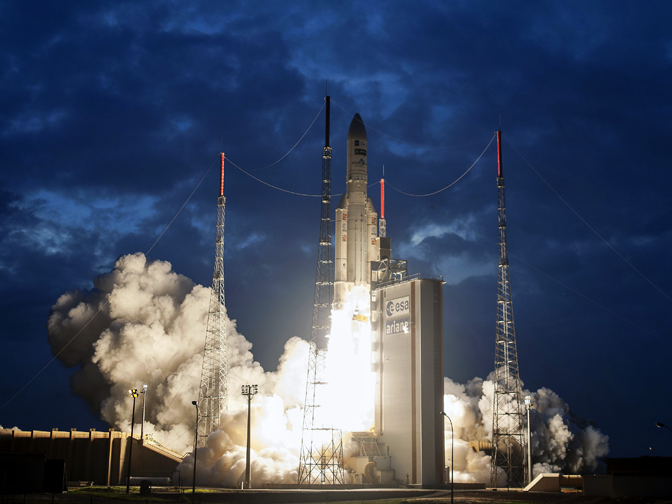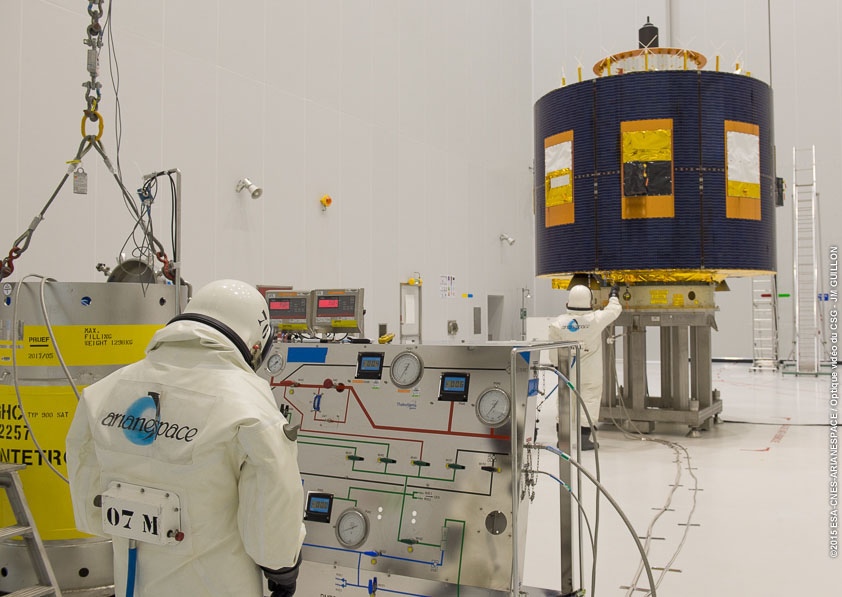

Europe’s latest weather satellite has gone into orbit after it was launched from Europe’s Spaceport in Kourou, French Guiana, late on 15 July.
The fourth Meteosat Second Generation (MSG-4) satellite lifted off at 2142 UTC on an Ariane rocket, from which it separated about 40 minutes later.
Meteosat satellites are operated by EUMETSAT, the European Organisation for the Exploitation of Meteorological Satellites. EUMETSAT’s Director-General, Alain Ratier, explained that MSG-4 will be stored in orbit for two and a half years and will then be exploited until two third-generation Meteosat satellites become operational in 2023.
Wind and water vapour
MSG-4 is the latest in a series of 11 geostationary Meteosat satellites that have gone into orbit since 1977. They fall into two groups: seven Meteosat First Generation satellites, of which only Meteosat-7 is still in service, and four Meteosat Second Generation satellites.
“MSG-4 will be the last of the second-generation Meteosat satellites, which set a new high standard for meteorological satellite imagery from geostationary orbit when the first was launched in 2002,” said Stephen English, the acting head of ECMWF’s Data Division.

The satellite's propulsion tanks are filled as part of the launch preparations. (Photo: ESA-CNES-ARIANESPACE)
ECMWF uses Meteosat data for numerical weather prediction (NWP) in two ways: cloud features can be tracked in a sequence of images to infer wind information, and the imagery measurements can be assimilated directly to provide information on water vapour.
“Once it goes into service, MSG-4 will ensure the continuation of this valuable data until the launch of third-generation Meteosats, which will provide yet another major advance in instrumentation capabilities,” Stephen explained.
Climate data
Some Meteosat satellites have provided valuable data for a very long time. Meteosat-7 was launched in 1997 and is the last surviving first-generation Meteosat. Stephen emphasized that it is “still providing useful data over the Indian Ocean 18 years later”.
“Such remarkable longevity means that not only are these data sources valuable for NWP, but they are forming an increasingly interesting long-term climate data record, used for example in ECMWF’s ERA-Interim climate reanalysis," he pointed out.
Other satellites
ECMWF assimilates selected data from a ring of geostationary satellites positioned above the equator. These include Meteosat but also American, Russian, Indian, Chinese and Japanese satellites. Together they give near complete imagery coverage between 60°S and 60°N.
The geostationary satellites are complementary to polar-orbiting satellites, which provide complete global coverage as well as atmospheric sounding capabilities.
While more traditional observations are still critically important, satellites now provide most of the data used in ECMWF’s models. Today more than 60 satellite data products are actively assimilated at ECMWF, more than twice as many as 10 years ago – and the trend is up.
Top photo: ESA-CNES-ARIANESPACE
